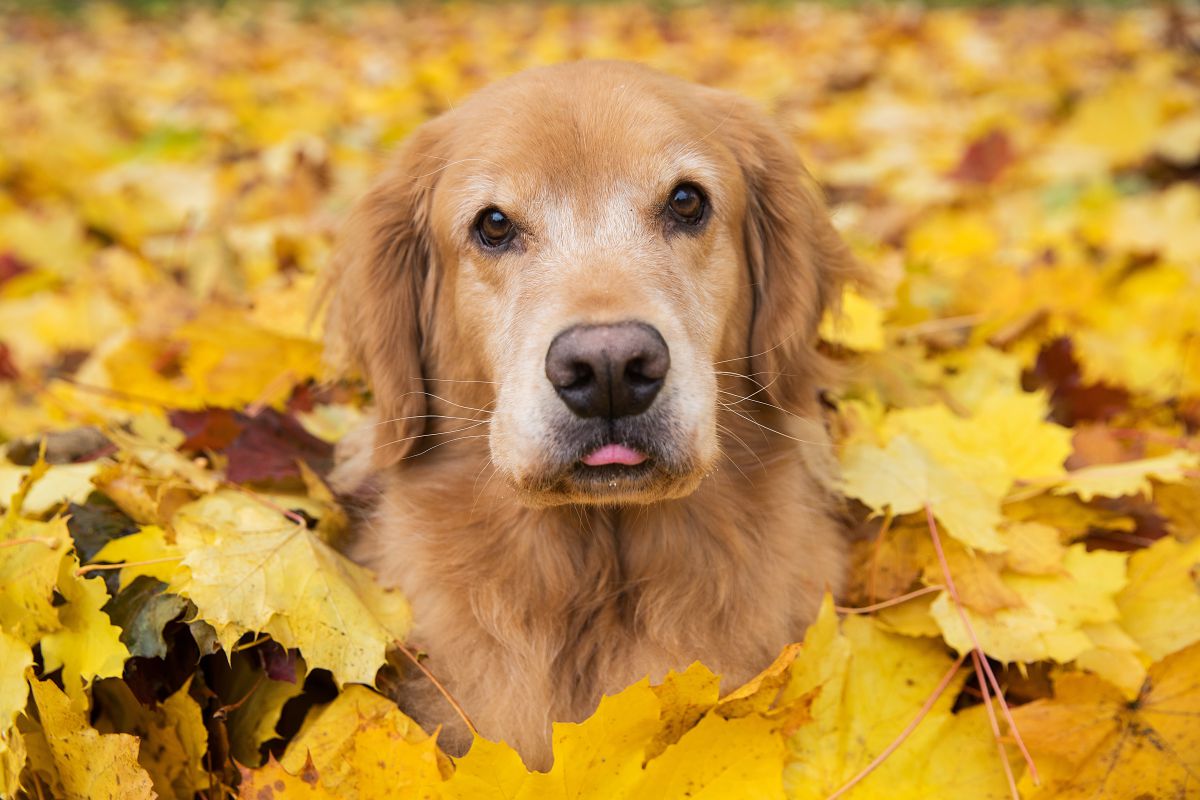Are you considering getting a furry companion but have allergies? If so, you may be wondering if Golden Retrievers are hypoallergenic dogs.
After all, these lovable and friendly animals are one of the most popular breeds worldwide, and for a good reason. They make excellent family pets and are known for their loyalty and playful nature.
However, before bringing a Golden Retriever into your home, it’s crucial to understand what hypoallergenic means and how it relates to dogs.
In this article, we’ll explore the hypoallergenic nature of Golden Retrievers and other dog breeds and the importance of fur type, breed history, grooming, and dander regulation.
By understanding these factors, you’ll be better equipped to make an informed decision about whether a Golden Retriever is the right dog for you, or if you should consider a different breed that’s better suited for allergy sufferers.
What Does Hypoallergenic Mean?
Looking to get a dog but have allergies? Let’s talk about what hypoallergenic really means.
The term ‘hypoallergenic’ refers to something that has a lower likelihood of causing an allergic reaction. When it comes to dogs, hypoallergenic breeds have specific fur types that produce less dander and allergens, making them a better option for people with allergies.
However, it’s important to note that no dog is entirely hypoallergenic, and all dogs produce some level of dander.
Dander is a microscopic flake of skin that dogs (and all animals) shed, and it’s the primary source of allergens that cause allergic reactions in humans.
Hypoallergenic breeds have characteristics that make them produce less dander, such as having a single coat or hair that grows continuously rather than shedding.
It’s worth noting, though, that even hypoallergenic breeds can produce dander, so regular grooming, pest control, a clean environment, a good diet, and good hygiene are essential to reduce the spread of dander.
Additionally, owning a dog has many health benefits, such as increased exercise, improved mental health, and reduced stress levels.
Fur Type Importance
Maintaining proper grooming and hygiene practices is crucial in reducing shedding and dander for breeds with certain fur types, including Golden Retrievers.
Their double coat shedding can produce a significant amount of dander, which can trigger allergies in sensitive individuals.
Regular brushing and bathing can help remove loose fur and dead skin cells, reducing the spread of dander.
Fur type maintenance is not the only factor in controlling allergy symptoms. Pest control, a clean environment, a good diet, and good hygiene also play a crucial role.
However, if you’re severely allergic to dogs, you may want to consider hypoallergenic alternatives such as the Portuguese Water Dog, Coton de Tulear, Soft-Coated Wheaten Terrier, Xoloitzcuintli, Peruvian Inca Orchid Dog, Chinese Crested Dog, or Havanese.
Keeping your dog healthy and well-groomed is essential for reducing shedding and dander and providing a comfortable environment for you and your furry friend.
Breed History
To fully understand the history of your furry companion’s breed, you may want to research their origins and how they were bred for specific purposes.
Golden Retrievers were first bred in Scotland in the mid-1800s by Lord Tweedmouth.
He aimed to create a dog that could retrieve game birds on land and water, with a gentle disposition and a willingness to please.
Tweedmouth crossed a yellow-colored retriever with a tweed water spaniel, which resulted in the golden retriever’s notable characteristics of a friendly, loyal, and obedient companion.
Golden Retrievers quickly gained popularity as hunting dogs and family pets in the UK and later in the US.
Their genetic makeup includes a double coat of fur, which sheds heavily, making them unsuitable for allergy sufferers.
However, their charming personality and versatility in various activities like obedience, agility, and therapy work continue to make them a beloved breed among dog owners.
Notable breeders of golden retrievers include Marjorie Satterthwaite, who’s credited with importing the first golden retrievers to the US in the 1920s.
Grooming and Fur Type
Regular grooming is essential to keep your furry companion’s coat healthy and reduce shedding.
Golden Retrievers have a double coat that can be challenging to maintain, but brushing your dog’s coat regularly with the right grooming tools can help prevent shedding and reduce allergens in your home.
Using a slicker brush and a metal comb can help remove tangles and loose fur. You can also use a de-shedding tool that helps remove loose fur without damaging the coat.
Coat maintenance is also important; regular baths with a gentle dog shampoo can keep your dog’s coat clean and healthy. However, over-bathing can lead to dry skin and increased shedding.
Consulting with a professional groomer can help you maintain your dog’s coat.
By following these grooming tips, you can help reduce shedding and allergens in your home, making it more comfortable for you and your furry friend.
Golden Retrievers and Allergies
If you’re concerned about allergies and considering getting a furry companion, it’s important to research and understand the different breeds that are less likely to cause allergic reactions.
Unfortunately, Golden Retrievers are not hypoallergenic dogs. Their double coat sheds heavily, making them unsuitable for those with severe allergies.
However, there are ways to manage Golden Retriever allergies, such as regular grooming, pest control, and keeping a clean environment.
Hypoallergenic dog breeds might be a better fit for you if you’re set on getting a dog but have allergies.
Some popular hypoallergenic dog breeds include the Portuguese Water Dog, Coton de Tulear, and Soft-Coated Wheaten Terrier.
These breeds have specific fur types that produce less dander, making them more suitable for those with allergies.
Understanding the pros and cons of hypoallergenic dog breeds is essential and choosing the right one for your lifestyle.
Non-shedding dog breeds also require specific care tips to keep their coats healthy, and natural remedies can help alleviate dog allergies.
Additionally, allergy-friendly dog accessories such as beds, collars, and toys can further reduce the spread of dander.
Keeping a Golden with Allergies
Now that we know Golden Retrievers aren’t hypoallergenic, you may be wondering what you can do to keep your furry friend around if you or someone in your household has allergies.
The good news is, there are steps you can take to reduce dander and minimize allergy symptoms.
First and foremost, regular grooming is crucial. Brush your dog’s coat daily to remove loose fur and prevent it from floating around your home.
Bathing your pup once a month with a hypoallergenic shampoo can also help reduce dander.
Additionally, keeping up with your dog’s pest control, providing a clean environment, and feeding them a healthy diet can all contribute to a healthier, less allergy-inducing pet.
If you’re looking for allergy-friendly activities to do with your dog, consider taking them on walks or playing fetch outside. Fresh air and exercise can help improve both human and canine health.
Certain health supplements and home remedies may help reduce allergy symptoms in both humans and dogs. It’s worth doing some research to see if any of these are right for you and your pup.
Regular Grooming
To keep your furry friend’s coat healthy and reduce allergy symptoms, it’s essential to groom them consistently.
Maximizing grooming frequency can help reduce the spread of dander and allergens.
A good rule of thumb is brushing your Golden Retriever at least once weekly. However, during shedding season, grooming them more frequently to keep their coat healthy and reduce shedding is recommended.
When it comes to grooming tools, it’s best to invest in a high-quality brush that can help remove loose fur and dirt.
Professional grooming services are also an option if you don’t have the time or expertise to groom your dog at home.
At home grooming techniques are just as effective with proper training and the right tools. Keeping your Golden Retriever’s coat clean and healthy can minimize allergy symptoms and enjoy your furry friend’s company without worry.
Pest Control Measures
Keeping your furry friend healthy and free from pests is crucial in reducing the spread of dander and maintaining a hypoallergenic home.
With Golden Retrievers, investing in pest prevention measures is especially important as they’re prone to flea and tick infestations due to their heavy coat.
Regularly using flea and tick prevention products, such as collars or topical treatments, can help keep these pests at bay and reduce the amount of dander they leave behind.
In addition to indoor cleaning and grooming, maintaining outdoor areas can also help reduce the spread of allergens.
Regularly mowing the lawn, trimming bushes, and removing any standing water can help prevent pests from settling in your yard and bringing dander inside.
If you’re struggling to control pests on your own, consider hiring professional services to help keep your home and yard pest-free.
By taking these precautions, you can help create a comfortable and hypoallergenic environment for both you and your furry friend.
Clean Environment Tips
Maintaining a clean environment is key if you want to create a comfortable and healthy home for your furry friend.
This is especially important if you or someone in your household suffers from allergies.
To keep your home allergen-free, start by investing in a good air filtration system. This will help to remove any airborne allergens, such as pet dander, from the air.
Another important step is to use hypoallergenic bedding for your dog. This will help to reduce the amount of dander that is released into the air when your dog sleeps.
Additionally, make sure to vacuum your home regularly using a vacuum cleaner with a HEPA filter. This will help to remove any pet hair and dander that may be lurking in your carpets and upholstery.
Finally, consider using special vacuuming techniques, such as in a zigzag pattern, to ensure that you remove as much pet hair and dander as possible.
By following these cleaning tips, you can create a comfortable and allergen-free home for your furry friend.
Importance of a Good Diet
You’ll want to make sure your furry friend is getting the right nutrients in their diet to help prevent excessive shedding and dander production.
Proper nutrition is key to keeping your dog healthy and reducing the amount of allergens they produce.
Make sure to feed your dog a balanced diet that meets their nutritional requirements and consider adding supplements to their food to help manage any allergies they may have.
When it comes to choosing the right food for your dog, make sure to read the labels carefully and avoid ingredients that may trigger allergies.
Some dogs may benefit from a grain-free or limited ingredient diet.
You’ll also want to establish a feeding schedule that works for you and your dog. If you’re looking to take it a step further, try making homemade dog food using safe and nutritious ingredients.
With a little effort, you can help keep your dog healthy and reduce the amount of shedding and dander they produce.
Good Hygiene Practices
Maintaining good hygiene practices for your furry friend is crucial for reducing the spread of allergens and ensuring their overall health and well-being.
Start with regular baths, but don’t bathe them too often as it can strip their skin of natural oils.
Aim for once every two to three months or as needed, and use a mild shampoo that’s recommended for dogs.
Brushing their coat frequently will also help remove loose fur and dander, preventing it from spreading throughout your home.
When it comes to dental care, it’s just as important for your furry friend as it is for you.
Regular teeth brushing and dental check-ups can help prevent bad breath, gum disease, and other dental issues that can contribute to the spread of allergens.
Additionally, maintaining an exercise routine and providing them with allergy medications as needed can also help keep them healthy and reduce the spread of allergens.
Consider using allergen-friendly home products, such as air filters and vacuum cleaners, to further reduce the spread of dander.
Remember, keeping your furry friend healthy and well-groomed is essential for reducing shedding and dander, and ultimately, for keeping you and your family healthy too.
Adult vs. Puppy Allergies

Now that you know the importance of good hygiene practices, it’s time to dive into the topic of adult vs. puppy allergies.
Did you know that some people may be allergic to puppies but not adult dogs? This is because puppies have less developed immune systems and may produce different allergens than adult dogs.
If you suspect that you or a family member may have allergies to dogs, it’s essential to get allergy testing done.
Allergy testing can help identify the specific allergen that triggers your symptoms, and your doctor can recommend appropriate treatment options.
If you do have dog allergies, there are several ways to manage them at home, such as regularly cleaning your home, using air purifiers, and washing your hands after playing with your dog.
In addition to traditional allergy treatments, some alternative allergy treatments, such as acupuncture and herbal remedies, may provide relief. However, speaking with your doctor before trying alternative treatments is essential.
Lifestyle changes may be necessary for severe allergy sufferers, such as choosing a hypoallergenic dog breed or avoiding contact with dogs altogether.
Remember, managing dog allergies is possible with the right precautions and treatment options.
Hypoallergenic Golden Retriever Mixes
If you’re looking for a mixed breed dog that has a lower chance of triggering allergies, consider exploring hypoallergenic Golden Retriever mixes.
These crossbreed options can include breeds like Poodle, Bichon Frise, or even the Chinese Crested Dog.
These mixes often have a similar temperament to Golden Retrievers, but with a coat that sheds less and produces less dander.
When considering a hypoallergenic Golden Retriever mix, it’s important to remember that grooming and dander control are still essential.
Regular grooming, including brushing and bathing, can help to reduce shedding and dander.
Pest control, a clean living environment, a healthy diet, and good hygiene practices can also help minimize dander spread.
Additionally, it’s important to research and choose allergy-friendly breeds that fit your lifestyle and needs.
Other Hypoallergenic Breeds
Exploring different breeds can broaden your options when searching for a furry companion that’s less likely to trigger allergies.
While Golden Retrievers may not be the best choice for allergy sufferers, there are plenty of other hypoallergenic breeds to consider.
Breeds like the Portuguese Water Dog, Coton de Tulear, Soft-Coated Wheaten Terrier, Xoloitzcuintli, Peruvian Inca Orchid Dog, Chinese Crested Dog, and Havanese have hair instead of fur, which means they shed less and produce less dander.
However, it’s important to note that no dog breed is entirely hypoallergenic, and even these breeds can still cause allergies for some people.
When comparing hypoallergenic breeds, it’s important to consider factors beyond just their allergy management.
Each breed has different exercise needs, training techniques, and coat maintenance requirements that may or may not align with your lifestyle.
For example, the Portuguese Water Dog needs a lot of exercises and mental stimulation, while the Chinese Crested Dog is more low-key.
The Soft-Coated Wheaten Terrier has a silky coat that requires regular grooming, while the Xoloitzcuintli has a short, easy-to-maintain coat.
By researching and comparing different breeds, you can find the perfect hypoallergenic dog that fits your lifestyle and allergy management needs.
Portuguese Water Dog
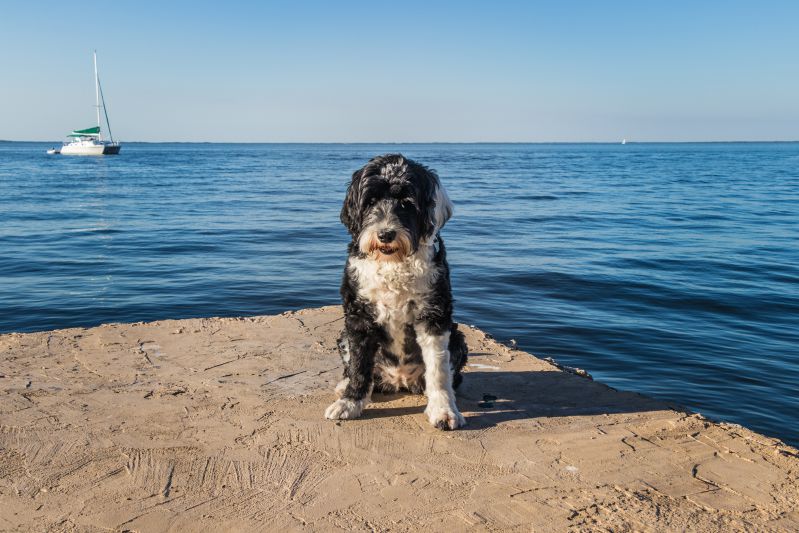
You might be interested in considering the Portuguese Water Dog as your next furry companion if you’re looking for a highly active breed that loves water activities.
These dogs are known for their excellent swimming skills and were originally bred to help fishermen retrieve nets and tackle from the water.
As a result, they require a lot of exercise and mental stimulation to remain happy and healthy. Make sure to provide plenty of opportunities for your Portuguese Water Dog to swim, play fetch, and run around in a safe and controlled environment.
In terms of training tips, it’s best to start socializing your Portuguese Water Dog from an early age.
These dogs can be shy and anxious if not properly exposed to new people and situations.
Positive reinforcement techniques such as clicker training and treats can be helpful in teaching your dog basic commands and tricks.
As for food options, choosing a high-quality, protein-rich diet that meets your dog’s nutritional needs is important.
Common health issues to watch out for in Portuguese Water Dogs include hip dysplasia, allergies, and eye problems.
Regular grooming is also essential, as these dogs have a curly, water-resistant coat that can easily become matted if not properly brushed and trimmed.
Coton de Tulear
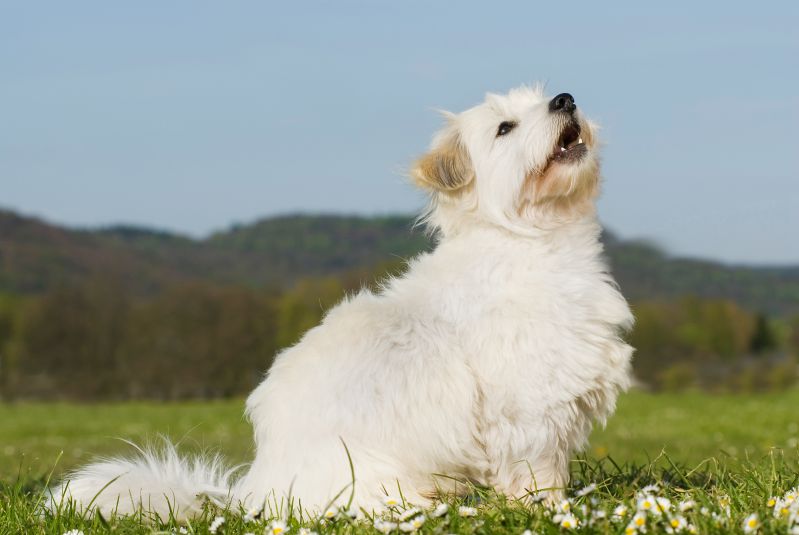
Now that you know about the hypoallergenic nature of Portuguese Water Dogs, let’s talk about another breed that might suit your needs – the Coton de Tulear.
These small dogs are known for their fluffy, cotton-like coats that shed minimally, making them an excellent choice for allergy sufferers.
Aside from their hypoallergenic qualities, Coton de Tulears are also famous for their sunny personalities.
They are affectionate, playful, and loyal dogs that make great family pets. However, they can be stubborn, so training them well from an early age is essential.
Positive reinforcement techniques work best with these dogs, and they respond well to treats and praise.
When it comes to shedding management, regular grooming is crucial to keep their coats healthy and free of tangles.
Additionally, these dogs are prone to certain health concerns, such as dental issues, ear infections, and luxating patella, so it’s essential to keep up with their vet visits.
As for exercise requirements, Coton de Tulears are relatively low-energy dogs and will do well with daily walks and some playtime indoors.
Soft-Coated Wheaten Terrier
If you’re looking for a lovable and energetic companion that doesn’t shed excessively, the Soft-Coated Wheaten Terrier might be the perfect choice for you.
This hypoallergenic breed is known for its soft and silky coat that doesn’t produce excess dander but requires regular grooming and coat maintenance to prevent matting and tangling.
The Soft-Coated Wheaten Terrier has a friendly and playful temperament, making it a great family pet.
They can be stubborn at times and requires consistent training to prevent unwanted behaviors. This breed also has high exercise requirements and enjoys long walks and playtime.
Originally from Ireland, the Soft-Coated Wheaten Terrier was bred as a farm dog and is known for its versatility in hunting, herding, and guarding.
Xoloitzcuintli
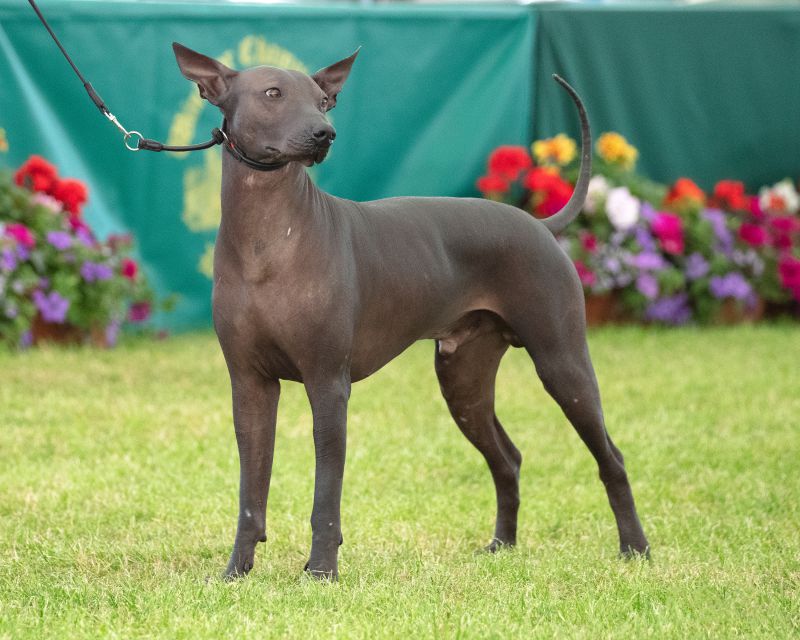
The Xoloitzcuintli, also known as the Mexican Hairless Dog, is a unique and ancient breed that is hypoallergenic due to its lack of fur. This breed comes in three sizes, toy, miniature, and standard.
Xoloitzcuintli has a lean, athletic build, and their skin is smooth and soft to the touch. They come in a range of colors, from black to brown to gray.
Xoloitzcuintli has a calm and affectionate temperament and is known to be loyal and protective of their family. This breed is intelligent and easy to train, but they can be stubborn at times.
To keep them healthy, you should provide regular exercise and socialization. Xoloitzcuintli can be sensitive to the cold, so they may need a sweater or coat during colder weather.
Moreover, they need regular dental care and grooming to maintain their skin’s health and prevent skin infections.
Peruvian Inca Orchid Dog
You’ll love the unique and elegant look of the Peruvian Inca Orchid Dog, a breed that is a great option for those with allergies. This breed is known for its hairlessness, which means they produce less dander.
The Peruvian Inca Orchid Dog, also known as the PIO, has a long history dating back to Incan times and was often used for hunting and as a companion.
They are a rare breed and can be a bit difficult to find, but they are worth the effort.
Grooming a PIO is relatively easy since they have no fur. However, they still need to be bathed and moisturized to keep their skin healthy.
Keeping their nails trimmed and teeth clean is important, as they are prone to dental issues.
When looking for a PIO, it’s essential to find a reputable breeder who can provide health clearances and genetic testing.
Training and socialization are also crucial for a PIO, as they can be shy and timid around strangers.
Overall, the Peruvian Inca Orchid Dog is a unique and lovely breed that can make a great addition to a family with allergies.
Chinese Crested Dog

Looking to add a unique and affectionate pet to your family? Consider the Chinese Crested Dog, a hypoallergenic breed that’s perfect for allergy sufferers.
Originally from China, this breed has a distinctive appearance with its hairless body, except for a tuft of fur on its head, paws, and tail.
The Chinese Crested Dog is a small breed that weighs between 5-12 pounds and has a life expectancy of 13-18 years.
When it comes to grooming, the Chinese Crested Dog requires regular bathing, sunscreen application, and nail trimming.
Due to their hairless nature, they’re prone to sunburn and need protection from harsh UV rays. It’s also essential to keep their skin moisturized with lotion or oil to prevent dryness and cracking.
As for health concerns, the breed is susceptible to dental problems, so regular teeth cleaning is a must.
Training the Chinese Crested Dog can be a bit challenging due to their stubborn nature, but with positive reinforcement techniques and consistency, they can be trained to be well-behaved and obedient.
Overall, the Chinese Crested Dog is an excellent choice for a family pet that’s hypoallergenic, affectionate, and unique in appearance.
Havanese
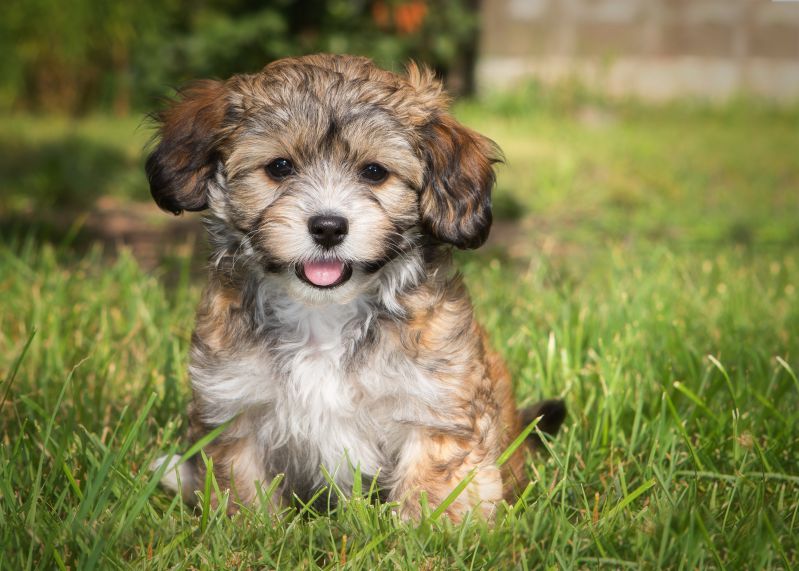
Now that you know about the Chinese Crested Dog, let’s talk about another hypoallergenic breed: the Havanese.
These little dogs are known for their silky, long hair, which may seem like a nightmare for allergy sufferers, but they actually shed very little and produce less dander than other breeds.
This makes them a great option for families looking for a hypoallergenic dog that is also friendly and affectionate.
Havanese are known for their playful and outgoing personalities. They love to be around people and are great with children. They’re also intelligent and eager to please, making them easy to train.
When it comes to grooming, their long hair requires regular brushing and trimming, but they’re generally low-maintenance.
They also require moderate exercise, such as daily walks, and can do well in apartments as long as they get enough playtime.
Overall, the Havanese is a lovely hypoallergenic breed that can make a great addition to any family looking for a cute and loving companion.
Regulating Dander with Good Health
Maintaining your furry friend’s good health through regular grooming, pest control, and a balanced diet can help regulate their dander and reduce allergies.
Regular grooming is essential to keep your dog’s coat clean and healthy and helps reduce shedding and dander.
Brushing your dog’s coat regularly removes loose fur and dander, preventing it from spreading around your home.
Keeping your dog’s nails trimmed, teeth clean, and ears free from wax and debris can help prevent skin infections and allergies.
Pest control is also crucial in reducing dander. Fleas and ticks can cause skin irritation, leading to excessive scratching and shedding.
By using flea and tick prevention products, you can protect your dog from these parasites and reduce their risk of developing skin infections.
A balanced diet is equally important for reducing shedding and dander. Feeding your dog high-quality food that meets their nutritional needs can help keep their coat shiny and healthy, reducing shedding and dander.
Incorporating regular exercise and behavioral training into your dog’s routine can also help regulate their dander and promote a healthy, allergy-friendly lifestyle.
Frequently Asked Questions
What is a hypoallergenic dog?
A hypoallergenic dog breed is one that’s less likely to cause an allergic reaction in people who are allergic to pet fur or dander. These dogs have a low allergen count, which means they produce fewer allergens than other dog breeds.
Are Golden Retrievers hypoallergenic?
No, Golden Retrievers are not considered hypoallergenic dogs. They have an undercoat that sheds a lot, and they’re one of the most popular dog breeds in the world. So, if you’re allergic to Golden Retrievers, you’re not alone.
Can I keep a Golden Retriever if I suffer from dog allergies?
If you’re allergic to Golden Retrievers, you should probably avoid getting one as a pet. However, that doesn’t mean you can’t have a dog at all. There are dogs that don’t shed much, such as poodles, Bichon Frises, and Yorkshire Terriers.
What causes allergies to Golden Retrievers?
The allergen that causes pet allergies is a protein found in the dog’s fur, skin flakes, saliva, and urine. When a person is allergic to this protein, the body sees it as a foreign invader that must be fought off. This triggers an allergic reaction, which can cause symptoms such as sneezing, runny nose, itchy eyes, and hives.
Are there any dog breeds that are hypoallergenic?
Yes, there are several dog breeds that are considered hypoallergenic, such as poodles, Bichon Frises, Yorkshire Terriers, and Maltese. These dogs don’t shed much, and they produce fewer allergens than other dog breeds.
If I’m allergic to Golden Retrievers, does that mean I’m allergic to all dogs?
No, being allergic to Golden Retrievers doesn’t necessarily mean you’re allergic to all dogs. Each dog breed produces a different amount of allergen, so you may be able to tolerate some breeds better than others. However, if you’re allergic to one dog breed, you’re more likely to be allergic to other breeds as well.
How can I reduce my allergies to Golden Retrievers?
If you’re allergic to Golden Retrievers, there are several things you can do to reduce your exposure to allergens. For example, you can keep the dog’s fur clean and groomed, vacuum your home regularly, use an air purifier, and keep the dog out of your bedroom. You can also take allergy medication or get allergy shots to help reduce your symptoms.
Can mini Golden Retrievers reduce allergies?
No, there’s no such thing as a mini Golden Retriever. There are some breeders that claim to sell mini Golden Retrievers, but this is not a recognized breed. If you’re looking for a smaller dog that sheds less and is less likely to cause allergies, consider adopting a different breed.
If I’m allergic to Golden Retrievers, can I still be a pet parent?
Yes, if you’re allergic to Golden Retrievers, you can still be a pet parent. There are many other pets that are less likely to trigger an allergic reaction, such as cats, fish, birds, or reptiles. You can also consider adopting a hypoallergenic dog breed, or getting a dog that doesn’t shed much.
Do all Golden Retrievers shed a lot?
Yes, shedding is a natural process for all dogs, including Golden Retrievers. This breed has a thick double coat that sheds heavily twice a year, and they also shed moderately throughout the year. However, some individual dogs may shed less or more than others, depending on their genetics, diet, and environment.
Can Golden Retrievers be considered hypoallergenic for people with mild allergies?
Golden Retrievers may not be the best choice if you have mild allergies. However, allergy management techniques such as regular grooming, air purifiers, alternative therapies, and allergy shots can help reduce symptoms. Consider hypoallergenic breeds like Portuguese Water Dog, Coton de Tulear, and Havanese.
What are some other hypoallergenic dog breeds besides Golden Retrievers?
Looking for hypoallergenic dog breeds? Consider the Portuguese Water Dog for their low-shedding coat and medium size. They have high exercise requirements and require regular grooming, but their affectionate and trainable temperament make them a great companion.
Are there any hypoallergenic Golden Retriever mixes?
Golden retriever mixes may not be hypoallergenic, but some breeds like Portuguese Water Dogs or Havanese are allergy friendly. Regular grooming routines, allergy shots, and air purifiers can also help reduce allergy symptoms. Remember to prioritize your health and wellbeing.
How can keeping your dog healthy help reduce shedding and dander?
To reduce shedding and dander, keep your dog healthy through regular grooming, a healthy diet, and an exercise routine. Consider using air purifiers and allergy-friendly bedding. Your dog will feel better and you’ll breathe easier.
What are some examples of good hygiene practices for dog owners to follow to reduce the spread of dander?
To reduce the spread of dander, regularly groom your dog, use cleaning supplies with hypoallergenic properties, invest in air filtration, limit exposure to certain areas, and consider allergy medicine. These good hygiene practices can benefit all dog owners.
Conclusion
So, are Golden Retrievers hypoallergenic dogs? Unfortunately, the answer is no. While they may shed less than other breeds, their fur still produces dander, saliva, and urine that can trigger allergic reactions in some people.
However, there are other breeds that may be more suitable for people with allergies. Consider the Peruvian Inca Orchid Dog, Chinese Crested Dog, and Havanese, which are all known for their hypoallergenic qualities.
Remember, it’s important to do your research and spend time with a breed before bringing them home to ensure they are a good fit for you and your family’s lifestyle and health needs.
With proper grooming and care, you can still enjoy the love and companionship of a furry friend without the added discomfort of allergies.

